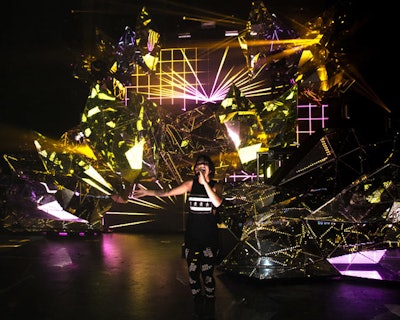
"My team at V Squared Labs and I are always pushing the envelope with existing technology to generate new forms of experiential visual art. The Volcano is our next experimental design integrating lighting, reflection mapping, and sculptural form," says Vello Virkhaus, founder of the Los Angeles-based visual arts studio. The impressive “Volcano” sculpture, which was designed for electronic music dance group Krewella’s current tour, consists of crystal-like structures made out of one- and two-way mirrored acrylic plastic with reflective backing that creates a mapping effect. Each crystal is also equipped with LED elements, resulting in the illusion that the structure is morphing from within.
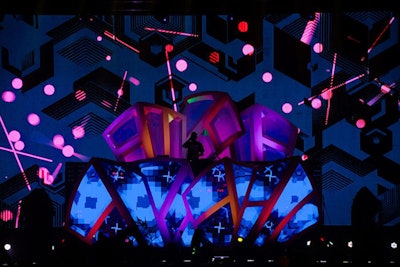
V Squared Labs teamed up with DJ Dillon Francis to create a new stage show featuring a unique Frank Gehry-inspired structure. The empty spaces within the 3-D video DJ booth are lined with a highly reflective mirrored vinyl to bounce video out into the audience, creating an almost psychedelic effect. Virkhaus describes his team’s colorful, twisted work as "Jeff Koons meets Atari 8-bit on a slice of pizza."

For Beyoncé’s world tour in 2013, stage designer LeRoy Bennett of Seven Design Works created a wall of light that could rival the Macy’s Fourth of July fireworks: LED strobes and custom mirror fixtures provided a range of illumination, from explosive bursts to a sparkling glow. “Beyoncé was looking for a show that was less video-based, unlike past tours, and more light-orientated,” says Bennett, who has also designed stages for other notable entertainers, including Bruno Mars and Paul McCartney.
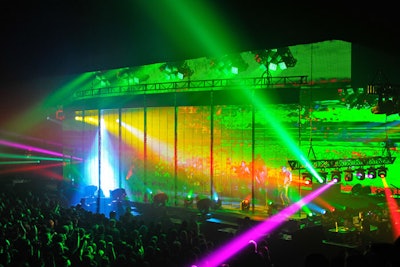
Bennett describes his stage design for Nine Inch Nails’s recent shows as “an advanced version of the Lights in the Sky tour,” referring to the band’s 2008 tour, which featured transparent screens and light structures. As the band’s longtime lighting designer, Bennett upgraded the technology this time around, adding a custom-built LED screen developed by video production company Nocturne. In addition to the tour stage, Bennett also created a roadworthy version for the band’s festival appearances—one that was ground-supported and didn’t rely on on-site production restrictions. The concept was based on the Talking Heads movie Stop Making Sense. “You start with an empty stage and build from there through many reveals and dynamics, then into a full-blown rock show.”
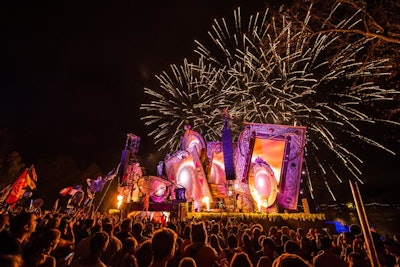
The Mythical Frames stage—one of seven at the electronic dance music festival held in Atlanta in September—featured a colossal collage of tilted LED screens that each projected imagery throughout the performances. Brought in from Belgium, where the event’s sister festival has taken place since 2005, the stages each had their own unique theme, including a fairy-tale scene, an Arabian palace, and a magical forest. The United States version of the five-day festival was produced in partnership with SFX Entertainment.
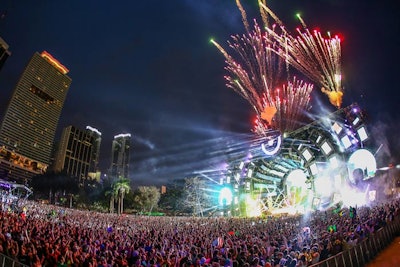
Inspired by a sci-fi spaceship, Richard Milstein, owner of Miami-based design company Skylab Industry and creative director of the Ultra Music Festival, designed a mesmerizing main stage for the electronic dance music show in March at Miami's Bayfront Park. Nicknamed “the Vortex,” the stage expanded outward with curved columns of LED panels and lights forming a conical shape for added depth, resulting in a hypnotizing effect.
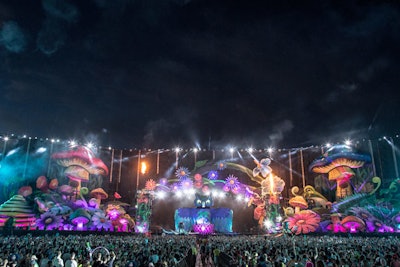
Produced by Insomniac Events, the Electric Daisy Carnival is known for elaborate scenery, carnival rides, and world-renowned DJs. In 2013, Mountain Productions engineered the main stage for the tour’s Sin City stop, which was held at the Las Vegas Motor Speedway in June. Able to withstand 90-miles-per-hour winds and constructed of 50 miles of scaffolding, it was the largest structure ever built by the Wilkes-Barre, Pennsylvania-based staging company. The animatronic owl, provided by the Attraction Services Company of Santa Clarita, California, included a “nest” where the DJs performed.
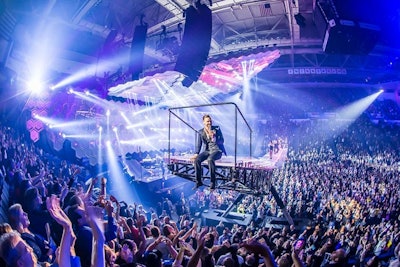
“With JT at the helm as creative director for the show, we worked very closely on translating his vision of the 20/20 albums, which he described as ‘visual music,’ into a very sensory live experience,” says New York-based stage and scenic designer Josh Zangen, who drew inspiration from modern art, futuristic environments, electronic dance music visuals, and even a fly’s eye for the stage design. The largest and most technically challenging element of the production, Zangen says, was the bridge: a 120-foot-wide piece of the stage that extends out over the audience, 250 feet above their heads, to the opposite side of the arena. Developed with Tait Towers, a stage set supplier based in Lititz, Pennsylvania, the bridge allows Timberlake to “connect with as much of the audience as possible in a completely new way”—without wires or flown elements. The 20/20 Experience World Tour wrapped up in January.



















